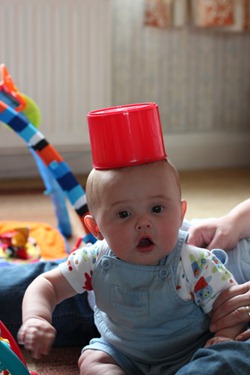Author's posts
Aug 13 2012
The Peevish Olympic Spectator
Since Team GB started scaling the heights of the medals table I have been gripped by patriotic fervour; I am an armchair critic able to pontificate on the rules of various sports: keirin is a cycling event involving chasing a moped, that turn in the womens backstroke looked a bit poor, Usain Bolt normally stops trying a few yards short of the line. Each morning I have checked our national progress in the medal table.
The medal table is interesting: the US and China are riding high, a function of their large populations and the importance they attach to the games, although early in the games the US position was driven by its performance in the pool. The Russians were doing poorly to start with but only on the basis of gold medals – the table is ranked by number of golds won. Australia have done less well than recently but again a shortage of gold medals has emphasised this. Looking back, Great Britain has bobbed around 10th position in the table since 1928 with a disastrous 36th position in Atlanta 1996 and a 4th position in the most recent games in Beijing – this year we have finished 3rd!
Before the games had started I was something of a cynic: it’s an expensive exercise ~£10bn with dubious financial return. Companies like mine have scaled back activities during the Games, in part to avoid partners getting dragged into the predicted but perhaps not real “travel chaos” in London. Prior to the games it was predicted that non-Olympic tourism to London would be reduced. The law has been re-written to protect brands sponsoring the Olympics not just from other companies but from the public, in view of this the spectacle of people being criticised for selling their Olympic torches on ebay was rather ironic. The sailing is taking place near where I grew up, in Weymouth, and the locals find themselves mightily disrupted. It’s been distressing to see the British media anticipating gold medals for British athletes to the extent where a silver or gold is almost seen a failure: “why didn’t you get a gold?”, in China this function is carried out by the state.
Aug 08 2012
Lords Reform – aftermath
Lords reform is looking quite dead, there is an outside chance that David Cameron is bluffing his 91 rebels – faced with the realisation that they may have just blow chances of a Tory win at the next election due to the loss of boundary changes, they may relent.
As for the boundary changes, I’m indifferent to them. In best case for Tories they address an imbalance in the electoral system for them which lost them the last election. To Liberal Democrats they mean nothing in a system which is grossly weighted against them. I believe the Tories may just get through the changes they want, the arithmetic is very tight and I wouldn’t put it past a group of Labour MPs to vote for on the grounds that they prefer kicking the Lib Dems to the Tories.
Labour’s behaviour has been laughable: this is a reform they say they believe in and yet they are happier to see it fall than vote with Liberal Democrats. Talk of a “badly written bill” is simply the flimsiest of pretexts to vote it down, the Bill is built on the work that Labour did on Lords Reform and was extensively consulted upon. “Badly written” is code for “we’re voting against because we’re automatic opposition”.
As for freeing up time in parliament in order to legislate to boost growth – I don’t think even socialists believe that legislation will boost growth – Tories spouting it is outright surreal.
The Tories have violated the Coalition Agreement – the Liberal Democrats have not. There is no careful algebra of this being tied to that: it has been broken. Even over tuition fees the Lib Dems kept their side of the bargain – the Tories haven’t. Liberal Democrats now opposing boundary changes is straightforward retribution – you break an agreement, there is a punishment.
We often piously say at election time that people have died for us to be able to vote. I’ve said it myself. It is utter cobblers: no one died so an appointed house of cronies, party funders and has been MPs could Lord it over us. No one died so that 37% of a turnout of 61% could give one party absolute power.
When you see Lords Reform in Labour and Tory manifestos at the 2015 general election have a hearty laugh and ignore them.
Aug 05 2012
My letter to Sir David Attenborough…
It seems Sir David Attenborough doesn’t think he has influenced people to take up science, some people have organised a letter writing to show how wrong he is, see here on how to contribute: http://dearsirdavid.wordpress.com/submission/
This is my contribution:
Dear Sir David,
I’m a scientist. I did a degree in Chemical Physics at Bristol University, a PhD in Polymer Physical Chemistry at Durham University and I became a lecturer in Biological Physics at UMIST, I still work as a scientist.
I understand you may not realise how many people you have inspired to become scientists, so I’m writing to say: you inspired me! As a child I was interested in the natural world; “Life on Earth” came along when I was nine years old. It was a grand story, it did not just cover the cute and fluffy animals, it went to Australia to look at the stromatolites. I went on to study the physical sciences formally but to me science is all one big story and you helped make that clear to me.
I eagerly awaited each new series you made, I still do, because they don’t insult my intelligence and I come away learning something new. Your recent First Life series is a fine example, I read about the Burgess Shale long ago but you visited those bleak places where the evidence of the first life on earth were found; were passionate about the un-imposing smears they left on the rock and told the story. I never knew trilobites had calcite eyes.
You can claim some matchmaking credit too: were it not for “Life on Earth”, my wife would not have attended Bristol University to do a degree and we would never have met!
You still inspire me because at an age where I might reasonably expect to be retired, you are being hoisted up trees, dropped on atolls by helicopter, and standing on mountains of bat dung.
Thank you, Sir David!
best regards
Dr Ian Hopkinson
I have to say I was welling up when I wrote this…
Aug 03 2012
Plastic Pots…
Jul 25 2012
Book review: A computer called LEO by Georgina Ferry
 This is a review of “A Computer called LEO” by Georgina Ferry, recounting the story of the first computer developed for business use by J. Lyons & Co, the teashop and catering company.
This is a review of “A Computer called LEO” by Georgina Ferry, recounting the story of the first computer developed for business use by J. Lyons & Co, the teashop and catering company.
Lyons formed in 1884, a spin-off from a family tobacconist company whose traveling salesman realised that there were few reliable teashops around the country, furthermore catering at large events such as the Great Exhibition was poor. Over the next 30 years or so the business grew, with a chain of teashops, and smarter establishments such as the Corner Houses and Trocadero. The teashops were supplied by Lyons own manufacturing and delivery service.
By the 1930s Lyons had approximately 30,000 workers, as such it was one of Britain’s larger employers. 300 clerks were used to tot up daily takings on mechanical calculators. Clerical work had risen in important during the second half of the 19th century with numbers rising from 70,000 in Britain in 1851 to 2 million in 1901. The company had a department of Systems Research led by a Cambridge mathematician, John Simmons, who the company had recruited in 1923, the hiring of such a graduate was a novelty at the time. The Systems Research department was interested in the efficient running of the business.
By this time various items of office machinery were commonplace, things such as filing cabinets, typewriters, mechanical calculators, and punch card readers. Telephone exchanges were in place, the electronic valve had been invented in the early years of the 20th century and magnetic storage devices were starting to become available. By the 1930s people such Oliver Standingford in Lyon’s Stock Department were talking about machines which would combine these elements, although he was not clear on the detail of how this would be done.
The Second World War then intervened, Lyons cut table service from its teashops as labour went short. Various people gained useful experience in electrical engineering through the wartime developments in radar, and possibly codebreaking. We now know that Colossus, a computer used for code breaking, was built at Bletchley Park during the war but it did not become public knowledge until 1974. In the US ENIAC had been developed at the Moore School in Philadelphia to do artillery range calculations. This was not a secret and immediately after the war, Oliver Standingford and Raymond Thompson visited from Lyons; they had a broad brief to investigate American business methods but it was ENIAC which really captivated them. Fortunately, their US trip put them in touch with more local expertise in the form of Douglas Hartree at Cambridge University who was building a computer, EDSAC, for the Mathematical Laboratory.
Lyons decided fairly quickly to construct their own computer, which was to be based on the EDSAC machine; US machines such as they were could not be purchased because of currency restrictions and there were no computer manufacturers in the UK. From the start LEO I (the first computer) was different, Simmons saw the computer fitting into a system of “scientific management” and as such LEO was crafted to exactly fit the role he foresaw for it based on detailed knowledge of the company’s processes. In some senses computing for business was more demanding than the computation done in the Mathematical Laboratory and other scientific laboratories: business computing had large demands for input and output (imagine a payroll system – it needs to read in details of each employee and print out the results), it had lower tolerance for failure (payroll failing to run has a serious impact on employees) and calculations could be more “complex” than mathematical ones in the sense that more steps in calculation and more conditionality was required. It was at Lyons that the art of flowcharting was developed. The first live duty that LEO carried out was in 1951, it was made public in 1955. It’s interesting to note that Charles Babbage had highlighted the potential for automation in both manufacturing and mathematical operations in his book “On the Economy of Machinery and Manufacturers”, published in 1832.
There were to be two further LEO computers, developed by a separate company, Leo Computers Ltd however things did not go well. The computers themselves were technically advanced, and the Leo Computers method of going into a business and closely examining their processes before writing programs and delivering a system combining both hardware and software usually had excellent results. However, this had the unfortunate side-effect of losing their best staff to their clients. Other problems were afoot: Leo Computers Ltd although nominally a separate company was under-resourced both financially and in personnel with development engineers also acting as salesman. The parent company, Lyons was struggling – victim of a family business mentality which put increasingly useless family members at the heads of divisions.
In 1964 Leo Computers Ltd was merged with English Electric, with Lyons divesting itself of any responsibility, following this union the LEO line died although the final computers in the series were installed by the Post Office, and continued to run there, in places, until 1981.
In contrast in the 1960s IBM were able to make an investment of $5billion on their System 360 computers – a compatible range designed to fit every need. They had a ready market in the US both of businesses willing to buy, unlike their British counterparts, and a government who bought locally first. Faced with this opposition, the British computer industry struggled to compete.
Focusing on the LEO computer makes this a human scale story with central cast of characters, but it also provides a wider view of the field in the years after the Second World War. The book makes clear how J. Lyons & Co had a system of management, and personnel in place which were ripe for computerisation; the developments in the 1930s made it clear that electronic computers were in the air. Large scale failures of computer systems in both public and private sectors are onging, John Simmons was rather insightful in his intimate coupling between business process and software system.
References
1. My Evernotes are here
2. The web page of the Leo Computer Society is http://www.leo-computers.org.uk/



